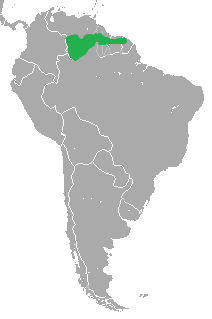
Opossums are members of the marsupial order Didelphimorphia endemic to the Americas. The largest order of marsupials in the Western Hemisphere, it comprises 126 species in 18 genera. Opossums originated in South America and entered North America in the Great American Interchange following the connection of North and South America.

Tyler's mouse opossum is a South American marsupial of the family Didelphidae. It lives in rainforests of the Guiana Highlands of southern Venezuela at elevations between 1300 and 2200 m. The species has only been found on three isolated tepuis. All three of these locations are in protected areas.
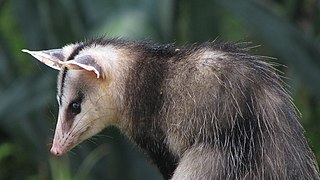
Didelphis is a genus of New World marsupials. The six species in the genus Didelphis, commonly known as Large American opossums, are members of the opossum order, Didelphimorphia.

The white-eared opossum, known as the timbu and cassaco in northeast Brazil, saruê and sariguê in Bahia, micurê and mucura in northern Brazil and comadreja overa in Argentina, is an opossum species found in Argentina, Bolivia, Brazil, Paraguay, and Uruguay. It is a terrestrial and, sometimes, arboreal animal, and a habitat generalist, living in a wide range of different habitats.
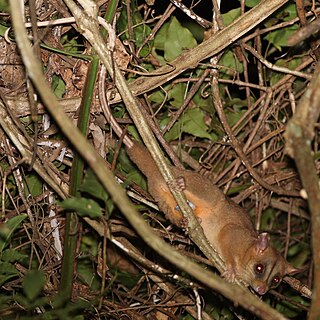
The bare-tailed woolly opossum is an opossum from South America. It was first described by Swedish zoologist Carl Linnaeus in 1758. The bare-tailed woolly opossum is characterized by a gray head, brown to gray coat, orange to gray underside and a partially naked tail. It is nocturnal and solitary; there is hardly any social interaction except between mother and juveniles and in mating pairs. The opossum constructs nests in tree cavities, and its litter size ranges from one to seven. Gestation lasts 25 days, and the juveniles exit the pouch after three months; weaning occurs a month later. The bare-tailed woolly opossum inhabits subtropical forests, rainforests, secondary forests, and plantations; its range extends from northern Venezuela to northeastern and southcentral Brazil. The IUCN classifies this opossum as least concern.

The brown-eared woolly opossum, also known as the western woolly opossum, is an opossum from South America. It was first described by German naturalist Ignaz von Olfers in 1818. The opossum is characterized by a brown to reddish brown coat and similarly colored limbs, yellow to orange underbelly, hairless, brown ears with a hint of pink, and a tail furred on the back for up to half of its length. The brown-eared woolly opossum is nocturnal, solitary and omnivorous. The IUCN lists it as least concern.

The black-shouldered opossum, also known as the white-eared opossum, is an opossum known from western Brazil and southeastern Peru. It was first described by Colin Campbell Sanborn, curator of Field Museum of Natural History, in 1951. The black-shouldered opossum is characterized by a gray coat, gray underbelly, and broad black stripes that extend from the forefeet, meet on the shoulders, run along the midline of the back and then split into parallel stripes that run down the hind feet. Little is known of the behavior of the black-shouldered opossum. It is nocturnal and arboreal. It is known to feed on fruits and rodents. The opossum inhabits humid forests. The IUCN classifies it as least concern.

The big-eared opossum, also known as a saruê, is an opossum species from South America. It is found in Argentina, Brazil and Paraguay.

The nine species in the genus Philander, commonly known as gray and black four-eyed opossums, are members of the order Didelphimorphia. Mature females have a well-developed marsupium. The tail appears to be hairless except for the proximal 5 or 6 cm, which has a few long hairs. The tail is slightly longer than the head-and-body length, and it is black for the proximal one half to two thirds of its length. The genus is closely related to Didelphis but the species of Philander are smaller than those of Didelphis. The genus formerly included Metachirus nudicaudatus, but this species lacks a pouch and so is now considered a separate genus. The common name comes from the white spots above the eyes, which can appear from a distance to be another set of eyes.

The common opossum, also called the southern or black-eared opossum or gambá, and sometimes called a possum, is a marsupial species living from the northeast of Mexico to Bolivia, including Trinidad and Tobago and the Windwards in the Caribbean, where it is called manicou. It prefers the woods, but can also live in fields and cities.

The neblina slender opossum is an opossum species from South America. It is found in Brazil, Ecuador, Venezuela, and perhaps Peru.

Derby's woolly opossum, or the Central American woolly opossum, is an opossum found in deciduous and moist evergreen forests of Central America, from southern Mexico to western Ecuador and Colombia. It was first described by English naturalist George Robert Waterhouse, and named in honor of Edward Smith-Stanley, 13th Earl of Derby. Derby's woolly opossum is the largest in its genus, with a total length of 60 to 70 centimetres and weight between 200 and 400 grams. The coat is brown and the underside white-buff to golden-brown. The opossum is nocturnal, arboreal (tree-living) and solitary. Diet consists of fruits, nectar, small invertebrates and vertebrates. The time when breeding takes place varies geographically. The litter size ranges from one to six. The IUCN classifies this opossum as least concern.
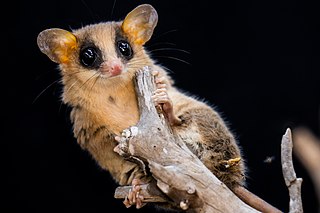
Gracilinanus is a genus of opossum in the family Didelphidae. It was separated from the genus Marmosa in 1989, and has since had the genera Cryptonanus, Chacodelphys, and Hyladelphys removed from it.

The Andean white-eared opossum is an opossum species from South America. It is found in the Andes Mountains, ranging from Venezuela to Bolivia.

The deltaic four-eyed opossum or delta opossum is a species of opossum found in the Orinoco River delta region of Venezuela, South America, first described in 2006. It inhabits perennially flooded swamp forest or seasonally flooded marsh forest of the adjacent deltas of the Orinoco and nearby rivers. Its dorsal fur is gray. Its ventral fur is cream-colored, but is restricted by the hairs on the sides, which are gray at the base. Its ears are colored only along the margins. The spots above its eyes are small. The spots behind its ears are small and inconspicuous.

Mondolfi's four-eyed opossum is a South American species of opossum found in Colombia and Venezuela, first described in 2006. It inhabits foothills of the Cordillera de Mérida and those on the eastern side of the Cordillera Oriental at elevations from 50 to 800 m. Populations in the two ranges may represent distinct subspecies. It is named after the Venezuelan biologist Edgardo Mondolfi. It has short woolly fur with a pale cream-colored venter as well as large ears pigmented on only the distal half.
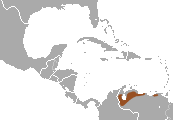
The hooded red-sided opossum is a South American opossum species of the family Didelphidae. Until recently, it was viewed as a subspecies of M. brevicaudata. It is found in Colombia and Venezuela at altitudes from sea level to 2250 m. It is a primarily nonarboreal resident of tropical rainforest, but has also been seen in areas under cultivation.

Guiana Amazonian Park is the largest national park of France, aiming at protecting part of the Amazonian forest located in French Guiana which covers 41% of the region. It is the largest park in France as well as the largest park in the European Union and one of the largest national parks in the world.

